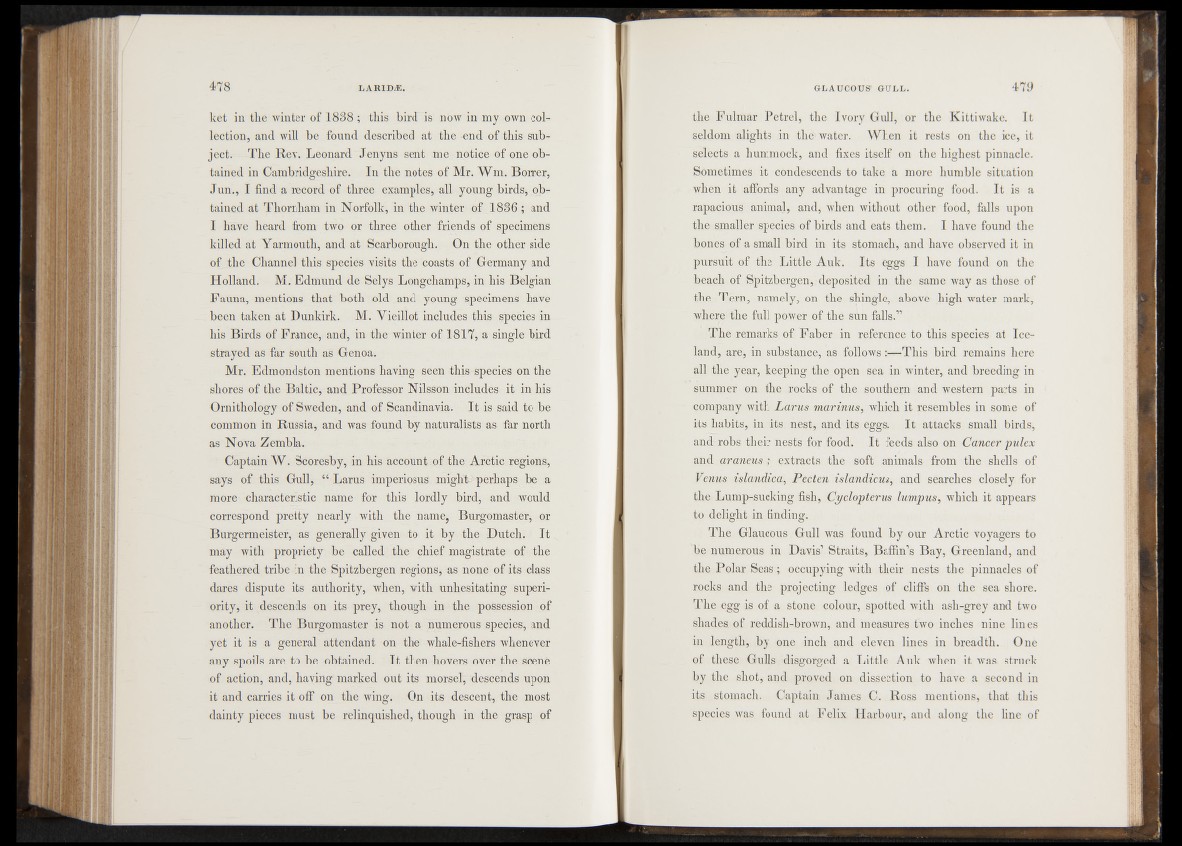
ket in the winter of 1838; this bircT is now in my own collection,
and will be found described at the -end of this subject.
The Rev. Leonard Jenyns sent me notice of one obtained
in Cambridgeshire. In the notes of Mr. Wm. Börrer,
Jun., I find a record of three examples, all young birds, ^obtained
fit Thornham in Norfolk, in the winter of. 1836; and
I have heard from two or three other friends of specimens
killed at Yarmouth, and at Scarborough. On the other side
of the Channel this species visits the coasts of Germany and
Holland. M. Edmund de Selys Longchamps, in his Belgian
Fauna, mentions that both old .and young specimens have
been taken at Dunkirk. M. Vieillot includes this species in
his Birds of France, and, in the~winter of 1817, a single bird
strayed as far south as Genoa.
Mr. Edmondston mentions having seen this-species on the
shores of the Baltic, and Professor NilsSon includes it in his
Ornithology of Sweden, and of Scandinavia, -dh is- said to be
common in Russia, and was found by naturalists-as far north
as Nova Zembla.
Captain W . Scoresby, in his a c c o u n ts the Arctic regions,
says of this Gull, “ Laras imperiosus, might- perhaps be a
more -characteristic name-for this lordly bird, and would
correspond pretty nearly with the name^ Burgomaster* or
Bürgermeister, as generally given to it by the Dutch. It
may with propriety be called the chief magistrate of the
feathered tribe -in the Spitzbergen regions, as none of its class
dares dispute its authority, when, with unhesitating superiority,
it ^descends on its prey, though in the possession of
another. The Burgomaster is not: a numerous species, and
yet it is a general attendant -on the whale-fishers whenever
any spoils are to be obtained. I t then hovers over the scene
of action, and, haying marked out its morsel; descends upon
it and carries it off on the wing. On its descent, the most
dainty pieces must be relinquished, though in the grasp of
the Fulmar Petrel, the Ivory Gull, or the Kittiwake. I t
seldom alights in thd> water. When it rests on the ice, it
selects a hummock, and fixes itself on the highest pinnacle.
Sometimes it condescends to take a more humble situation
when it affords any advantage in procuring food. I t is a
rapacious animal, and, when without other food, falls upon
the smaller species of bird's and eats them. I have found the
bones of a small bird in its stomach, and have observed it in
pursuit of the Little Auk. Its eggs I have found on the
beach of Spitzbergen,;deposited in the same way as those of
the Tern, namely, on the shingle, above high water mark,
where'the full power of the sikn falls.”
The remarks of Faber in reference to this species at Iceland;,
are, in substance, as follows:—This bird remains here
all the year, keeping the open sea in winter, and breeding in
summer on the rocks of the southern and western parts in
company with Larus marinus, which it resembles in some of
its habits, in its, nest, and-its eggs. I t attacks small birds,
and-robs their nests foir food. I t feeds also on Cancer pulex
sxxdaraneus; extracts the soft animals from the shells of
Venus islandica, Pecten islandicus, and searches closely for
the Lump-sucking fish, Cyclopterus lumpus, which it appears
to delight in finding.
The Glaucous Gull was found by our Arctic voyagers to
gag numerous in Davis1 Straits, Baffin’s Bay, Greenland, and
the Polar Seas; occupying with their nests the pinnacles of
rocks and the projecting ledges of cliffs on the sea shore.
The egg is of a stone colour, spotted with ash-grey and two
shadea^of reddish-brown, and measures two inches nine lines
in length, by one inch and eleven lines in breadth. One
of these Gulls disgorged a Little Auk when it was struck
by the shot, and proved on dissection to have a second in
its stomach. Captain Jafnes C. Ross mentions, that this
species was found at Felix Harbour, and along the line of